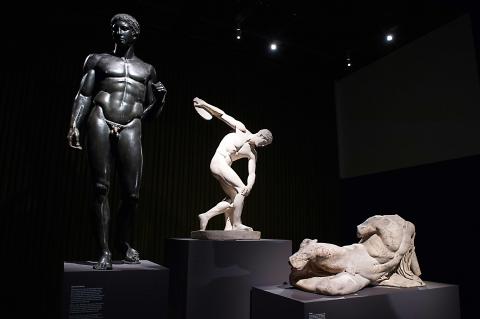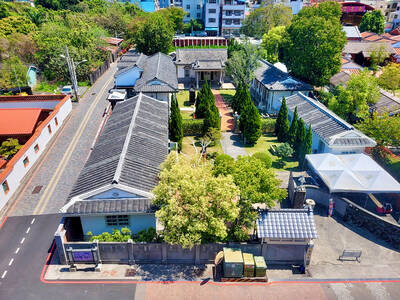The nude sculptures of the ancient Greeks depict what they believed to be the perfect human form, and the results still dazzle and move us thousands of years on, as the British Museum’s latest exhibition demonstrates.
Defining Beauty is a stunning array of sculptures and ceramics that includes some of the most familiar works of Greek antiquity.
The exhibition also compares how other cultures treated the human form and their attitudes to nudity, from the Mayans to the Assyrians.

Photo : AFP PHOTO/LEON NEAL
“The Greeks invented the human being,” Ian Jenkins, the exhibition’s curator, said, pointing to Greek philosophy, mythology and democracy, not just the aesthetics of the sculptures that dominate the exhibition.
The exhibition opens with the striking view of a nude goddess Aphrodite from behind. When visitors walk around the statue, they are met with her guarded, threatening gaze.
Though Greek in origin, she is a Roman copy. So is the discus thrower, Myron’s Diskobolos, a study in the perfect “balance of opposites,” and some of the other statues in the exhibition.
But the museum does display its own prized Greek originals which are the source of a long-running dispute with Greece. Athens has repeatedly called for the return of marble statues from the Parthenon, known as the Elgin Marbles, which were taken from Greece in 1816.
The Greek government protested angrily at the end of last year when the museum loaned one of them to Russia.
Officials at the British Museum acknowledge the difficulty in managing relations with Greece, who did not loan any items to the museum for the exhibition.
Part of the Parthenon’s frieze and the statue of Ilissos, recently returned from Russia, are on display and are a highlight of the exhibition.
Its last piece is Pheidias’s Dionysos, the Greek god of wine, theatre and religious ecstasy. The statue is placed next to a red chalk drawing of a man, drawing attention to the resemblance between the two reclining figures.
The sketch in question is Study for Adam by Michelangelo as he prepared to paint his famous fresco on the ceiling of the Sistine Chapel. Next to Dionysos, it is clear where the Italian master drew his inspiration from, consciously or not, more than a millennium later.

April 28 to May 4 During the Japanese colonial era, a city’s “first” high school typically served Japanese students, while Taiwanese attended the “second” high school. Only in Taichung was this reversed. That’s because when Taichung First High School opened its doors on May 1, 1915 to serve Taiwanese students who were previously barred from secondary education, it was the only high school in town. Former principal Hideo Azukisawa threatened to quit when the government in 1922 attempted to transfer the “first” designation to a new local high school for Japanese students, leading to this unusual situation. Prior to the Taichung First

Chinese Nationalist Party (KMT) Chairman Eric Chu (朱立倫) hatched a bold plan to charge forward and seize the initiative when he held a protest in front of the Taipei City Prosecutors’ Office. Though risky, because illegal, its success would help tackle at least six problems facing both himself and the KMT. What he did not see coming was Taipei Mayor Chiang Wan-an (將萬安) tripping him up out of the gate. In spite of Chu being the most consequential and successful KMT chairman since the early 2010s — arguably saving the party from financial ruin and restoring its electoral viability —

The Ministry of Education last month proposed a nationwide ban on mobile devices in schools, aiming to curb concerns over student phone addiction. Under the revised regulation, which will take effect in August, teachers and schools will be required to collect mobile devices — including phones, laptops and wearables devices — for safekeeping during school hours, unless they are being used for educational purposes. For Chang Fong-ching (張鳳琴), the ban will have a positive impact. “It’s a good move,” says the professor in the department of

Toward the outside edge of Taichung City, in Wufeng District (霧峰去), sits a sprawling collection of single-story buildings with tiled roofs belonging to the Wufeng Lin (霧峰林家) family, who rose to prominence through success in military, commercial, and artistic endeavors in the 19th century. Most of these buildings have brick walls and tiled roofs in the traditional reddish-brown color, but in the middle is one incongruous property with bright white walls and a black tiled roof: Yipu Garden (頤圃). Purists may scoff at the Japanese-style exterior and its radical departure from the Fujianese architectural style of the surrounding buildings. However, the property